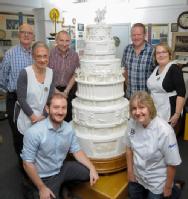WMG News
Queen’s wedding cake resurrected with scanning tech for 70th Anniversary
 Cutting-edge technology has brought Queen Elizabeth II’s wedding cake back to life in time for hers and Prince Philip’s 70th anniversary, thanks to research by WMG at the University of Warwick.
Cutting-edge technology has brought Queen Elizabeth II’s wedding cake back to life in time for hers and Prince Philip’s 70th anniversary, thanks to research by WMG at the University of Warwick.
Professor Mark Williams at WMG, alongside the British Sugarcraft Guild (BSG), employed 3D scanning technology to recreate a full-sized replica of a cake presented to the royal couple on their wedding day in November 1947 – which was almost totally destroyed by vandals in 2015.
The technology was able to accurately scan the cake to within 0.1mm and reproduce a high-resolution 3D model that was then be used to digitally repair the cake.
Analysing the surviving parts of the cake – an intricate 6ft ensemble, consisting of 6 tiers – Professor Williams was able to discover exactly how it was formed, and to determine precisely how to restore its original grandeur.
There were elaborate pictorial panels on each tier of the cake, the moulds of which had been lost through the decades. However, WMG’s engineering technology recreated these images from the wedding cake, and produced new silicone moulds through 3D scanning.
The historic cake – which was originally created by Peek Frean in 1947 - weighed six hundred pounds, and at the top stood a solid silver figure of St George and the Dragon, which was given to the royal couple as a souvenir.
This ornament remains in the Royal Collection, but WMG researchers were allowed into Buckingham Palace earlier this year to laser scan it so a replica could be made. This was proudly placed on the cake top during the final assembly by WMG Project Engineer Mike Donnelly.
Queen Elizabeth wrote of the cake how she and Prince Philip “admired the beauty of its design and the excellence of its quality.”
The life-sized model was displayed in the Peek Frean & Co factory until its closure in 1989. A permanent exhibition about the company later opened in a South-East London museum – of which the cake was a major part – although during a change of premises for the museum, the cake was left behind, as it was too delicate and precious to transport.
During this time, the iconic cake was vandalised, and almost completely destroyed – but will now be returned to its former glory, thanks to the innovative solutions offered by WMG.
Professor Mark Williams comments:
“It was fantastic to apply our technology to such an exciting project and help restore such an iconic cake to its former glory, especially in the year of the Queen’s 70th wedding anniversary.
"Usually we are working on engineering-related challenges, so to be able to take our expertise and transfer that to something totally different and so historically significant was a really interesting opportunity.”
The tiers of the cake were distributed to the seven BSG regions in Autumn 2016, together with the materials, templates and plans for each relevant tier.
BSG Members’ Workshops across the country used these plans to recreate the historic cake.
Judith Lynn, BSG National Vice Chairman, comments:
“The British Sugarcraft Guild was honoured to be invited to recreate the replica of the Queen’s wedding cake for the Peek Frean Museum. Our members have shown enormous enthusiasm for the project and the generosity of all our sponsors has been amazing.
“The experience of working with WMG at the University of Warwick in creating the 3D models to enable the moulded elements of the cake to be reproduced has been very rewarding. It illustrates perfectly how modern technology and traditional crafts can work in harmony to recreate such an important historic piece of sugar art.”
The finished replica cake will be unveiled at the Peek Frean Museum in Bermondsey at the end of November in the presence of the sponsors and other invited guests. Following this the museum will once again be open to the public.
